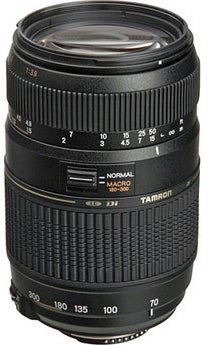This budget superzoom option boasts close focusing and low-dispersion glass, but what do we think of it overall?
Tamron AF 70-300mm f/4-5.6 Di LD Macro Review
Tamron’s is the most compact lens in this group test. The wide zoom ring is closest to the camera body and only the AF/MF slider is further rearwards. The focus ring is wider than is to be found on the competitors’ lenses, which aids manual operation but also increases the risk of stray fingers impeding its rotation in AF mode. That said, the likelihood of inhibiting the focusing action is still very slight. A slider controls the focusing range to switch between Normal and Macro, which is available only at longer focal lengths and delivers a maximum magnification of 0.5x. The close-up facility can be used either with manual focusing or in AF mode.
Rotating the zoom ring to its maximum focal length gives the lens a total length of about 180mm, inviting a further-forward grip than is adopted at shorter focal-lengths. At this point the Tamron’s rotating focus ring becomes a problem and the imposed grip means the lens cannot be steadied as well as would otherwise be the case. Coupled with the lack of IS, this makes accurate framing of distant scenes difficult. The AF mechanism is also a little on the slow side but it is accurate and reliable provided that is not brought to bear on rapidly moving subjects.
As is usual for 70-300mm zooms, the Tamron’s MTF performance is weakest at its 300mm setting but at least it just rises above the critical 0.25 cycles-per-pixel level (though not enough to raise its Image Quality score).






